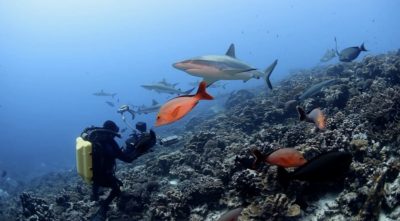Sharks Take a Bite
(2016)
Back in the summer of 2013, while conducting the Global Reef Expedition mission to French Polynesia, a team of cinematographers and researchers from Khaled bin Sultan Living Oceans Foundation were documenting shark feeding without the use of bait or other attractants. This article in Sierra summarizes that effort along with the resulting Emmy award winning film, Sharks of the Coral Canyon.
Sharks Take a Bite
 Sierra
Sierra
January 29, 2016
Noah Schlager
The grey reef shark is a fairly standard looking shark—torpedo body, tall dorsal fin, teeth protruding just outside its mouth. No strange adaptations like those found in hammerheads, threshers, or wobbegongs. Despite how common the sharks may appear, researchers are still making exciting new discoveries about them.
Back in the summer of 2013, a team of cinematographers and researchers from Khaled bin Sultan Living Oceans Foundation recorded for the first time grey reef sharks feeding without the use of bait or other attractants. While in French Polynesia documenting coral reefs, the team learned of a site where marbled grouper aggregate every summer to spawn—and a large population of grey reef sharks that feed on them. They knew they had to seize the opportunity to document such a unique event.
Sure, we’ve all seen videos of sharks tearing at a frozen chumsicle on Shark Week, but this sort of frenzy is completely artificial. To capture natural feeding behavior requires seeking out healthy reefs with large shark populations, and having the patience and skill to wait for a feeding event to occur.
Even then, you have to have your camera and lights in the right direction. “The cameramen have to be both creative and technical,” says Philip Renaud, executive director of the foundation. “I think it takes a special breed of people to be an underwater cameraman….You have to be disciplined.”…